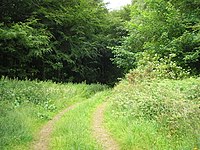Helen Hope
Helen Hope (1677 – 19 April 1768) was a Scottish forester and countess of Haddington through marriage. She planted many trees in Haddingtonshire and created Binning Wood at Tyninghame.
Early life
Helen Hope was born to Lady Margaret Hamilton and John Hope in Kirkliston, Linlithgowshire. She was baptized on 28 September 1677. Hope's brother Charles was born in 1681 and later became a peer and governor of the Bank of Scotland.[1] When she was five, her father drowned whilst travelling with the Duke of York (later to be King James VII of Scotland).[2] Her mother arranged her marriage to her first cousin Thomas Hamilton, 6th Earl of Haddington in 1696, at which point she became the countess of Haddington.[2]
Career

Hope lived with her husband at Leslie House in Fife and had the first of four children, who was named Charles and had the title of Lord Binning from birth.[2] Charles would become a politician and Knight Marshal of Scotland.[3] In 1700, the family moved to the earl's ancestral home, Tyninghame House in Haddingtonshire. Hope immediately wanted to plant trees despite the initial disinterest of her husband and local people.[2]
She decided to plant trees on the moorland of Tyninghame and call it Binning Wood in honour of her son.[2] The 800-acre (320 ha) estate was planted with 50 species of tree. In addition, she created a wilderness zone and a bowling green from where 14 walks began.[4] Her husband wrote Short Treatise on Forest Trees (published posthumously in 1756 and later reissued as Treatise on the Manner of Raising Forest Trees in 1761), in which he praised Hope's efforts.[2][5]
Death and legacy
Hope died in Edinburgh on 19 April 1768 at the age of 90. She was buried alongside her husband (who had predeceased her) at Tyninghame.[2] An obelisk constructed in 1856 by Thomas Hamilton, 9th Earl of Haddington pays tribute to the couple's extensive planting.[6]
Binning Wood was clearfelled in the 1940s as part of the war effort. The Landowners’ Co-operative Society Limited of Edinburgh recorded 89% of the wood was hardwood (oak and beech) and the remainder was softwood, mainly Scots pine. Some of the beechwood was used to construct de Havilland Mosquito fighter planes.[7] It was replanted in a program which took until 1960 to complete, with the trees mainly being Scots pine since hardwood seedlings were not available.[7] The earl of Haddington ensured the original 1707 layout was adhered to and the work was done by Italian prisoners of war.[8] In the 2010s, part of the wood became a green funeral site, with individual plots costing £950.[9]
References
- ^ "Hope, Charles, first earl of Hopetoun". Oxford Dictionary of National Biography (online ed.). Oxford University Press. doi:10.1093/ref:odnb/13716. (Subscription or UK public library membership required.)
- ^ a b c d e f g "Hope, Helen, countess of Haddington". Oxford Dictionary of National Biography (online ed.). Oxford University Press. doi:10.1093/ref:odnb/70532. (Subscription or UK public library membership required.)
- ^ "Hamilton, Charles, Lord Binning". Oxford Dictionary of National Biography (online ed.). Oxford University Press. doi:10.1093/ref:odnb/12052. (Subscription or UK public library membership required.)
- ^ Horwood, Catherine (2010). Gardening Women: Their Stories From 1600 to the Present (eBook). Little, Brown Book Group. ISBN 978-0-7481-1833-5. Retrieved 25 July 2020.
- ^ "Hamilton, Thomas, sixth earl of Haddington". Oxford Dictionary of National Biography (online ed.). Oxford University Press. doi:10.1093/ref:odnb/12128. (Subscription or UK public library membership required.)
- ^ Historic Environment Scotland. "TYNINGHAME (GDL00380)". Retrieved 25 July 2020.
- ^ a b "Forestry". The Fourth Statistical Account of East Lothian. 16 April 2018. Retrieved 28 October 2020.
- ^ "Whitekirk & Tyninghame". The Fourth Statistical Account of East Lothian. 16 April 2018. Retrieved 28 October 2020.
- ^ "Forest of rest: An alternative way to rest in peace". www.scotsman.com. 23 November 2010. Retrieved 28 October 2020.
